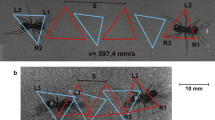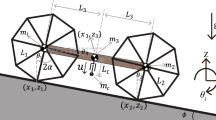Summary
The wind-orientated walk of carrion beetles Necrophorus humator F. was analysed under closed-loop conditions with a walking compensator and under openloop conditions with a paired tread wheel (Fig. 1).
-
1.
On the walking compensator an animal runs stable courses with a preferred direction relative to an air current (velocity =; 100 cm/s, Fig. 2B-D). A change in the air-current direction causes a corresponding adjustment of the mean walking direction (Fig. 3). Such course adjustment works best for changes in the air-current direction by an absolute value of 90° (Table 2).
-
2.
Under closed-loop conditions the animal shows deviations of less than ± 45° around its preferred direction relative to the wind (Fig. 2B-D). The characteristic curve which describes the animal's angular velocity as a function of the animal's walking direction relative to the air-current stimulus is therefore revealed only in this angular range (Fig. 3, top).
-
3.
Under open-loop conditions, however, complete characteristic curves can be obtained because the animal's walking reaction in response to any given angle of air-current stimulus is measurable on the paired tread wheel (Fig. 4). The characteristic curves are approximately sinusoidal functions. They can either show a shift parallel to the ordinale by a superimposed direction-independent constant angular velocity alone or, at the same time, they can independently exhibit an angular shift along the abscissa (Fig. 5).
-
4.
The walking tracks straighten with increasing air-current velocity (Fig. 6A, insets), i.e. the animal more rapidly compensates deviations from a preferred course. This corresponds to higher amplitudes of the characterisic curve and steeper slopes at the negative zero-crossing point under open- as well as under closed-loop conditions (Fig. 6).
-
5.
Walking in an air-current field can be explained by a model of the course control system using a feedback loop (Fig. 7). This model operates according to a sinusoidal characteristic function on which is superimposed a Gaussian white noise process of angular velocity which is independent of walking direction. The model produces realistic walking tracks in an air-current field (Fig. 8).
Similar content being viewed by others
References
Batschelet E (1981) Circular statistics in biology. Academic Press, London New York Toronto Sydney San Francisco
Bell JW, Kramer E (1979) Search and anemotactic orientation of cockroaches. J Insect Phyiol 25:631–640
Birukow G (1958) Zur Funktion der Antennen beim Mistkäfer (Geotrupes silvaticus). Z Tierpsychol 15:265–276
Böhm H, Scharstein H (1988) Perception and processing of air current information in the course control system of walking beetle. In: Elsner N, Barth FG (eds) Sense organs; interfaces between environment and behaviour. Thieme, Stuttgart New York, p 90
Böhm H, Schildberger k, Huber F (1991) Visual and acoustic course control in the cricket Gryllus bimaculatus. J Exp Biol 159:235–248
Böhm H, Wendler G (1987) Die Windorientierung von Aaskäfern. Mitt Dtsch Ges Allg Angew Entomol 6:91–94
Borst A, Heisenberg M (1982) Osmotropotaxis in Drosophila melanogaster. J Comp Physiol 147:479–484
Butenandt E (1968) Wirkungstheoretische Analyse der Menotaxis bei Calliphora. In: Drischl N, Tiedt (eds) Biokybernetik. Bd II. Karl-Marx-Universität, Leipzig, pp 58–63
Edrich W (1977) Interaction of light and gravity in the orientation of the waggle dance of honey bees. Animal Behav 25:342–363
Gewecke M (1972) Antennen und Stirnscheitelhaare von Locusta migratoria L. als Luftströmungs-Sinnesorgane bei der Flugsteuerung. J Comp Physiol 80:57–94
Gewecke M (1975) The influence of air-current sense organs on the flight behaviour of Locusta migratoria L. J Comp Physiol 103:79–95
Götz KG (1980) Visual guidance in Drosophila. In: Siddiqi O, Babu P, Hall LM (eds) Development and neurobiology of Drosophila. Plenum Press, New York, pp 391–407
Graham D (1981) Walking kinetics of the stick insect using a low inertia counter-balanced, pair of independent treadwheels. Biol Cybern 40:49–57
Hassenstein B (1951) Ommatidienraster und afferente Bewegungsintegration (Versuche am Rüsselkäfer Chlorophanus viridis). Z Vergl Physiol 33:301–326
Heinzel HG (1982) Rezeption von Luftströmungen und ihre Bedeutung für den Flug der Wanderheuschrecke. In: Nachtigall W (ed) Insect flight. BIONA-report 2, Akad Wiss Mainz; G Fischer, Stuttgart New York, pp 53–69
Heinzel H-G, Böhm H (1983) Die Windorientierung laufender Käfer (Necrophorus humator F.). Verh Dtsch Zool Ges 76:287
Heinzel H-G, Böhm H (1989) The wind-orientation of walking carrion beetles. J Comp Physiol A 164:775–786
Heinzel H-G, Gewecke M (1979) Directional sensitivity of the antennal campaniform sensilla in locusts. Naturwissenschaften 66:212
Heisenberg M (1983) Initiale Aktivität und Willkürverhalten bei Tieren. Naturwissenschaften 70:70–78
Heran H (1962) Anemotaxis und Fluchtreaktion des Bachläufers Velia caprai. Z Vergl Physiol 46:129–149
Jander R (1957) Die optische Richtungsorientierung der Roten Waldameise (Formica rufa L.). Z Vergl Physiol 40:162–238
Jander R (1959) Spontaneous changes in the angular orientation of animals. Abstr Anat Record 134:587
Jander R (1963) Insect orientation. Annu Rev Entomol:95–114
Jander R (1970) Ein Ansatz zur modernen Elementarbeschreibung der Orientierungshandlung. Z Tierpsychol 27:771–778
Kramer E (1975) Orientation of the male silk moth to sex attractant bombykol. In: Denton DA, Coglan JD (eds) Olfaction and taste 5. Academic Press, New York, pp 329–335
Kramer (1976) The orientation of walking honey bees in odour field with small concentration gradients. Physiol Entomol 1:27–37
Linsenmair KE (1969) Anemotaktische Orientierung bei Tenebrioniden und Mistkäfern (Insecta, Coleoptera). Z Vergl Physiol 64:154–211
Linsenmair KE (1970) Die Interaktion der paarigen antennalen Sinnesorgane bei der Windorientiemng laufender Mist und Schwarzkäfer (Insecta, Coleoptera). Z Vergl Physiol 70:247–277
Linsenmair KE (1973) Die Windorientierung laufender Insekten. Fortschr Zool 21:59–79
Lönnendonker U (1984) Der Beitrag von Fixation und Optomotorik an der Orientierung laufender Kartoffelkäfer. Doct Thesis, Universität Köln, Germany
Mittelstaedt H (1951) Zur Analyse physiologischer Regelkreise. Verh Dtsch Zool Ges 1951:150–157
Mittelstaedt H (1963) Bikomponenten-Theorie der Orientierung. Ergeb Biol 26:253–258
Müller JK, Cordes R (1987) Vergleich der tageszeitlichen Aktivitätsverteilung der Aaskäfer Necrophorus humator und N. vespilloides (Coleoptera). Verh Dtsch Zool Ges 80:321
Poggio T, Reichardt W (1976) Visual control of orientation behaviour in the fly. Part II. Towards the underlying neural interactions. Q Rev Biophysics 9:377–3438
Preiss R (1980) Anemo taxis im Lauf und Flug beim Schwammspinner: Versuche zur Aufklärung des Wirkungsgefüges. Doct Thesis, Universität München, Germany
Reichardt W, Poggio T (1976) Visual control of orientation behaviour in the fly. Part I. A quantitative analysis. Q Rev Biophysics 9:311–375
Scharstein H (1975) Der Mechanismus der Sollwertverstellung bei der Kursregelung der roten Waldameise (Formica polyctena). Doct Thesis, Universität München, Germany
Scharstein H (1977) Wie steuern Insekten ihr Laufverhalten im Dunkeln? In: Hauske G, Butenandt E (eds) Kybernetik. R Oldenbourg, München Wien, pp 384–387
Schildberger K, Kleindienst HU (1989) Sound localization in intact and one-eared crickets. J Comp Physiol A 165:615–626
Schmitz B (1983) Analyse der akustischen Orientierung bei Grillenweibchen Gryllus campestris. Doct Thesis, Universität Köln, Germany
Schoenemann B (1984) Das Gegenwendeverhalten und seine Steuerung. Eine Analyse bei Landasseln (Oniscus asellus). Doct Thesis, Universität Köln, Germany
Schöne H (1962) Optisch gesteuerte Lageänderung. (Versuche an Dytiscidenlarven zur Vertikalorientierung). Z Vergl Physiol 45:590–604
Schöne H (1973) Raumorientierung, Begriffe und Mechanismen. Fortschr Zool 21:1–19
Schöne H (1984) Spatial orientation. The spatial control of behavior in animals and man. Princeton University Press, Princeton New York
Stabel J (1987) Der Mechanismus der Richtungsbestimmung und seine Beziehung zur Gesangserkennung bei der Phonotaxis der Grille (Gryllus bimaculatus De Geer). Doct. Thesis, Universität Köln, Germany
Stabel J, Wendler G, Scharstein H (1985) The escape reaction of Acheta domesticus under open loop conditions. In: Gewecke M, Wendler G (eds) Insect locomotion. Paul Parey, Berlin Hamburg, pp 79–85
Stabel J, Wendler G, Scharstein H (1989) Cricket phonotaxis: Localization depends on recognition of the calling song pattern. J Comp Physiol A 165:165–177
Wendler G (1975) Physiology and system analysis of the gravity orientation in two insect species (Carausius morosus, Calandra granaria). Fortschr Zool 23:33–46
Wendler G, Scharstein H (1986) The orientation of grain weevils (Sitophilus granarius): Influence of spontaneous turning tendencies and gravitational stimuli. J Comp Physiol A 159:337–389
Wendler G, Heinzel H-G, Scharstein H (1984) Paired tread wheels as a tool for analysis of orientation behaviour in arthropods. In:Varjú D, Schnitzler HU (eds) Localization and orientation in biology and engineering. Springer, Berlin Heidelberg New York, pp 179–172
Author information
Authors and Affiliations
Rights and permissions
About this article
Cite this article
Böhm, H., Heinzel, HG., Scharstein, H. et al. The course control system of beetles walking in an air-current field. J Comp Physiol A 169, 671–683 (1991). https://doi.org/10.1007/BF00194896
Accepted:
Issue Date:
DOI: https://doi.org/10.1007/BF00194896




